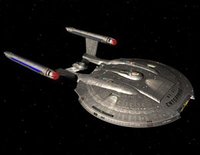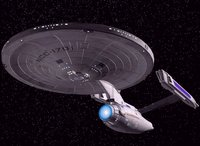Starship Enterprise
|
|
Stc_entb.JPG
Ambwall.jpg
TV_star_trek_tng_enterprise_D.jpg
Sovereign-2.jpg
In the Star Trek fictional universe, the USS Enterprise is the name given to a series of starships. Several of these vessels are considered focal points in the fictional universe created by Gene Roddenberry.
The USS Enterprise was once referred to as the "United Space Ship Enterprise", but ever since has always been "United Star Ship". Since Starfleet is unrelated to the United States armed forces, any similarity between this phrase and the American warship prefix "United States Ship" is purportedly coincidental. However, the prefix is intended to play off of the affinity that many have for the USS Enterprise series of naval vessels.
In honor of Star Trek, as well as the real vessels, a real space shuttle was also named Enterprise by NASA. To return the favor, a starship in Star Trek: Enterprise was named for the lost Space Shuttle Columbia. The second USS Enterprise aircraft carrier appeared in Star Trek IV: The Voyage Home. Note: The USS Enterprise featured in the movie was actually the USS Ranger (CVA-61). The actual USS Enterprise was out to sea during filming. It is questionable whether the Navy would have allowed the filming crew aboard Enterprise had she been available; at the time, the internal arrangements of the USN's nuclear carrier engineering plants were classified.
Not only the name, but also the associated hull number ("NCC-1701") has been bestowed upon different fictional ships at different times:
| Contents |
List of starships bearing the name
The Starship Enterprises that have been seen in the various TV series and movies to date are as follows
- Enterprise (NX-01), NX class, seen in Enterprise
- USS Enterprise, (NCC-1701), Starship class/Constitution class, seen in The Original Series and the first three movies, plus the Star Trek: Deep Space Nine episode, "Trials and Tribble-ations."
- USS Enterprise, (NCC-1701-A), Constitution class refit, seen in the fourth–sixth movies
- USS Enterprise, (NCC-1701-B), Excelsior class , seen briefly in Star Trek: Generations (the seventh movie)
- USS Enterprise, (NCC-1701-C), an Ambassador class, seen in the TNG episode "Yesterday's Enterprise"
- USS Enterprise, (NCC-1701-D), Galaxy class, seen in The Next Generation and the film Star Trek: Generations
- USS Enterprise, (NCC-1701-E), Sovereign class, seen in three of the TNG movies (8-10)
- USS Enterprise, (NCC-1701-J), seen briefly in the Enterprise episode "Azati Prime" (possible alternate future).
The existence of an Enterprise-J indicates the existence of an Enterprise-F, -G, -H, and -I at some point in history, however as yet no canonical information has been provided regarding these vessels. Since the future in which the Enterprise-J is depicted in "Azati Prime" is undone by the ending of the Xindi threat and the collapse of the Temporal Cold War, it remains to be seen if the vessel will ever actually exist in any future canon.
An additional spaceship (not necessarily starship) Enterprise is visible in an illustration on display in the recreation room of the NCC-1701 in Star Trek: The Motion Picture. It was later shown on a wall in 2143 San Francisco in the Enterprise episode "First Flight", meaning that its top speed was apparently less than warp 2. The ring-shaped design suggests application of Vulcan propulsion technology. The design was based on Matt Jefferies' early designs for the NCC-1701.
List of known captains
The lists below are of captains officially recognized in the Star Trek canon, with additional non-canon captains of note listed afterwards.
NX-01
- Jonathan Archer (Star Trek: Enterprise- 2151-2161; alternate timeline (episode "Twilight") 2151-2153; Mirror Universe I.S.S. Enterprise, 2155)
- T'Pol (alternate timeline: 2153-2156, Star Trek: Enterprise episode "Twilight")
- Charles "Trip" Tucker III (alternate timeline: 2156-2165, Star Trek: Enterprise episode "Twilight")
- Lorian (alternate timeline: unknown date-2154, episode "E2")
- Maximillian Forrest (Mirror Universe I.S.S. Enterprise c.2151-55, episode "In a Mirror, Darkly")
NCC-1701
- Christopher Pike (Star Trek episode "The Cage")
- James T. Kirk (Star Trek, Star Trek: The Motion Picture, Star Trek II: The Wrath of Khan, Star Trek III: The Search for Spock)
- Willard Decker (Star Trek: The Motion Picture)
- Spock (Star Trek II: The Wrath of Khan)
Star Trek: The Animated Series introduced Robert April as captain of the Enterprise prior to Pike. However, the animated series is not considered canonical, so Pike remains, officially, the first known captain of the NCC-1701, unless a future TV episode or film establishes otherwise. Although the official startrek.com website identifies April as the first captain, website information is considered a print source by Paramount and, thus, non-canon. The Star Trek: Deep Space Nine episode "Crossover" strongly suggests that Spock took command of the Mirror Universe I.S.S. Enterprise from Kirk soon after the events of "Mirror, Mirror".
NCC-1701-A
- James T. Kirk (Star Trek IV: The Voyage Home, Star Trek V: The Final Frontier, Star Trek VI: The Undiscovered Country)
NCC-1701-B
- John Harriman (2293-unknown) Star Trek: Generations)
Several non-canon sources have also named other captains of the Enterprise-B, however these are not considered official. According to several novels, Harriman was succeeded by Demora Sulu as captain. A poster of the NCC-1701-D also listed one Tomas Johnson Jr. as captain, but no information is offered as to when he might have commanded the vessel. Non-canon sources also suggest that Harriman's command ended in 2311.
NCC-1701-C
- Rachel Garrett (?-2344, Star Trek: The Next Generation episode "Yesterday's Enterprise") - The Enterprise-C was transported 22 years into an alternate future, therefore Garrett actually died in 2366.
- Richard Castillo (2344) - Succeeded Garrett when the Enterprise-C returned to 2344 and is assumed to have died in the ensuing battle with Romulan forces upon the vessel's return to the proper timeline.
NCC-1701-D
- Jean-Luc Picard (entirety of ST:TNG series, barring exceptions below)
- William Riker (during the Borg Crisis, as well as in several alternate timelines and futures)
- Edward Jellico (during Cardassian negotiations)
- Thomas Halliway (mentioned as being captain - but not seen - during the alternate future depicted in the episode "Tapestry")
NCC-1701-E
NCC-1701-F
- As yet unrevealed. A non-canonical novel (Imzadi by Peter David) featured Data as the captain of the Enterprise-F. However, even in the non-canonical story that future was undone.
NCC-1701-J
- Captain Archer was transported onboard the Enterprise J to discuss his role in history. The captain of this vessel is not revealed.
Originally, Star Trek:The Next Generation was to be set to take place 200 years after the adventures of the original crew. The original plans called for the series to take place on board the USS Enterprise (NCC-1701-G).
See also
- Virgin Galactic V.S.S. Enterprise, proposed first commercial spacecraft, named after the Star Trek vessels.
External links
- Template:Memoryalpha article
- NASA link on the naming of the first Space Shuttle (http://science.ksc.nasa.gov/shuttle/resources/orbiters/enterprise.html)de:Enterprise (Raumschiff)
es:Enterprise fr:Enterprise it:Astronave Enterprise ja:エンタープライズ (スタートレック) nl:Enterprise (Star Trek) pl:Enterprise (Star Trek)



